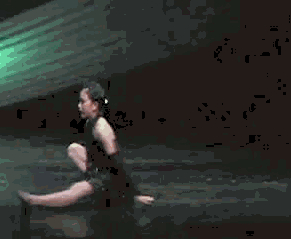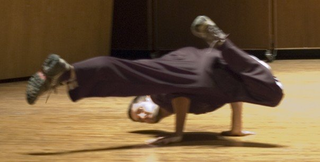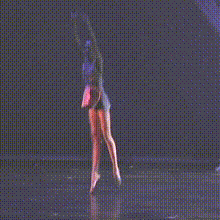
A back walkover is an acrobatic maneuver in which a person transitions from a standing position to a back bridge and then back to a standing position again, undergoing a complete revolution of the body in the process. Back walkovers are commonly performed in a variety of athletic activities, including acro dance, cheerleading, and rhythmic gymnastics. In artistic gymnastics, back walkovers are performed in floor exercises and on the balance beam.

A handstand is the act of supporting the body in a stable, inverted vertical position by balancing on the hands. In a basic handstand, the body is held straight with arms and legs fully extended, with hands spaced approximately shoulder-width apart and the legs together. There are many variations of handstands, all of which require the performer to possess adequate balance and upper body strength.
The snatch is the first of two lifts contested in the sport of weightlifting followed by the clean and jerk. The objective of the snatch is to lift the barbell from the ground to overhead in one continuous motion. There are four main styles of snatch used: snatch, split snatch, power snatch, and muscle snatch. The full lift is the most common style used in competition, while power snatches and muscle snatches are mostly used for training purposes, and split snatches are rarely used. Any of these lifts can be performed from the floor, from the hang position, or from blocks. In competition, only lifts from the floor are allowed.

An aerial cartwheel or side aerial is an acrobatic move in which a cartwheel is executed without touching hands to the floor. During the execution of a standard cartwheel, the performer's body is supported by the hands while transitioning through the inverted orientation whereas an aerial cartwheel, performer is airborne while inverted. To compensate for lack of support from the hands, leg momentum is employed to keep the performer airborne until the leading foot touches down. Aerial cartwheels can be executed while running or from a stationary, standing position. The front leg lunges and the back leg drives back creating momentum. Aerial cartwheels are also known by various other names, including side flip, side somersault, air cartwheel, no-hands cartwheels, or simply aerials.

A moonsault, moonsault press, or back flip splash is a professional wrestling aerial technique. It was innovated by Mando Guerrero. Much of its popularity in both Japanese and American wrestling is attributed to The Great Muta, despite it being used in North America by "Leaping" Lanny Poffo years before Muta came from Japan. In a standard moonsault, which is generally attempted from the top rope, a wrestler faces away from the supine opponent and executes a backflip landing on the opponent in a splash/press position but facing towards the elevated position. Though this move is generally attempted from the top rope to an opponent lying face up in the mat, myriad variations exist, including moonsaults that see the wrestler land on a standing opponent and forcing them down to the mat. The move is considered a higher-impact version of a splash, since the wrestler utilizes rotational speed.

A cartwheel is a sideways rotary movement of the body. It is performed by bringing the hands to the floor one at a time while the body inverts. The legs travel over the body trunk while one or both hands are on the floor, and then the feet return to the floor one at a time, ending with the athlete standing upright. It is performed in a variety of athletic activities, including performance dance and some types of Indian dance, in gymnastics and cheer, and in the martial arts of capoeira. It is called a cartwheel because the performer's arms and legs move in a fashion similar to the spokes of a turning (cart) wheel. In classical Indian Karana dance, it is called talavilasitam, and in capoeira is called aú.

A handspring is an acrobatic move in which a person executes a complete revolution of the body by lunging headfirst from an upright position into an inverted vertical position and then pushing off from the floor with the hands so as to leap back to an upright position. The direction of body rotation in a handspring may be either forward or backward, and either kind may be performed from a stationary standing position or while in motion. Body movement may be terminated upon completion of a handspring, or the performer's momentum may be leveraged so as to immediately perform another handspring or other rotational move.

The flare is an acrobatic move in which the performer alternates balancing the torso between either arm while swinging the legs beneath in continuous circles. It is a fundamental b-boying/bgirl power move, and in gymnastics it may be performed on a pommel horse or during the floor exercise. The move is commonly spelled flair in gymnastics and further may be called a "Thomas flair" after its originator, Kurt Thomas.

A kip-up is an acrobatic move in which a person transitions from a supine, and less commonly, a prone position, to a standing position. It is used in activities such as breakdancing, gymnastics, martial arts, professional wrestling, and freerunning, and in action film fight sequences.

The float (turtle) is a b-boying move originally coming from basic Gymnastics alongside variants specifically the Turtle. Though it appears to demand great strength, the float actually requires balance above all because the breaker's weight is supported on the elbows which are firmly planted ("stabbed") into the lower abdomen near the anterior superior iliac spine.

The cat righting reflex is a cat's innate ability to orient itself as it falls in order to land on its feet. The righting reflex begins to appear at 3–4 weeks of age, and is perfected at 6–9 weeks. Cats are able to do this because they have an unusually flexible backbone and no functional clavicle (collarbone). The tail seems to help but cats without a tail also have this ability, since a cat mostly turns by moving its legs and twisting its spine in a certain sequence.

A split is a physical position in which the legs are in line with each other and extended in opposite directions. Splits are commonly performed in various athletic activities, including dance, figure skating, gymnastics, contortionism, synchronized swimming, cheerleading, martial arts, aerial arts and yoga as exercise, where a front split is named Hanumanasana and a side split is named Samakonasana. A person who has assumed a split position is said to be "in a split", "doing a split", or "doing the splits".

A nip-up is an acrobatic spring from a supine position to a standing position. It is executed by propelling the body away from the floor so that the performer is momentarily airborne, and typically ends with the performer standing in a squatting position. It is performed in a variety of activities, including acro dance, breakdancing, gymnastics, martial arts, professional wrestling, parkour and freerunning.

A front walkover is an acrobatic movement sequence. It begins with the performer standing up straight with arms raised and positioned near to the ears. The performer then lunges forward and quickly raises one leg, with the other leg following as if transitioning to a handstand. The legs are held straight in a split as they travel overhead. The back is then arched until the leading foot touches the floor, such that the performer is briefly in a back bridge position. After the trailing foot reaches the floor, the performer returns to a standing position. In gymnastics, a front walkover typically ends with one foot extended in front and arms raised. Front walkovers are performed in various activities, including acro dance, circus, and gymnastics.
This is a general glossary of the terms used in the sport of gymnastics.

An acrobatic flip is a sequence of body movements in which a person leaps into the air and then rotates one or more times while airborne. Acrobatic flips are performed in acro dance, free running, gymnastics, cheerleading, tricking, goal celebrations and various other activities. This is in contrast to freestyle BMX flips, in which a person revolves in the air about a bicycle.

In dance and gymnastics, a turn is a rotation of the body about the vertical axis. It is usually a complete rotation of the body, although quarter (90°) and half (180°) turns are possible for some types of turns. Multiple, consecutive turns are typically named according to the number of 360° rotations.
A roll is the most basic and fundamental skill in gymnastics class. There are many variations in the skill. Rolls are similar to flips in the fact that they are a complete rotation of the body, but the rotation of the roll is usually made on the ground while a flip is made in the air with the hips passing over the head and without any hands touching the ground. Rolls also help recover from a fall safely.















